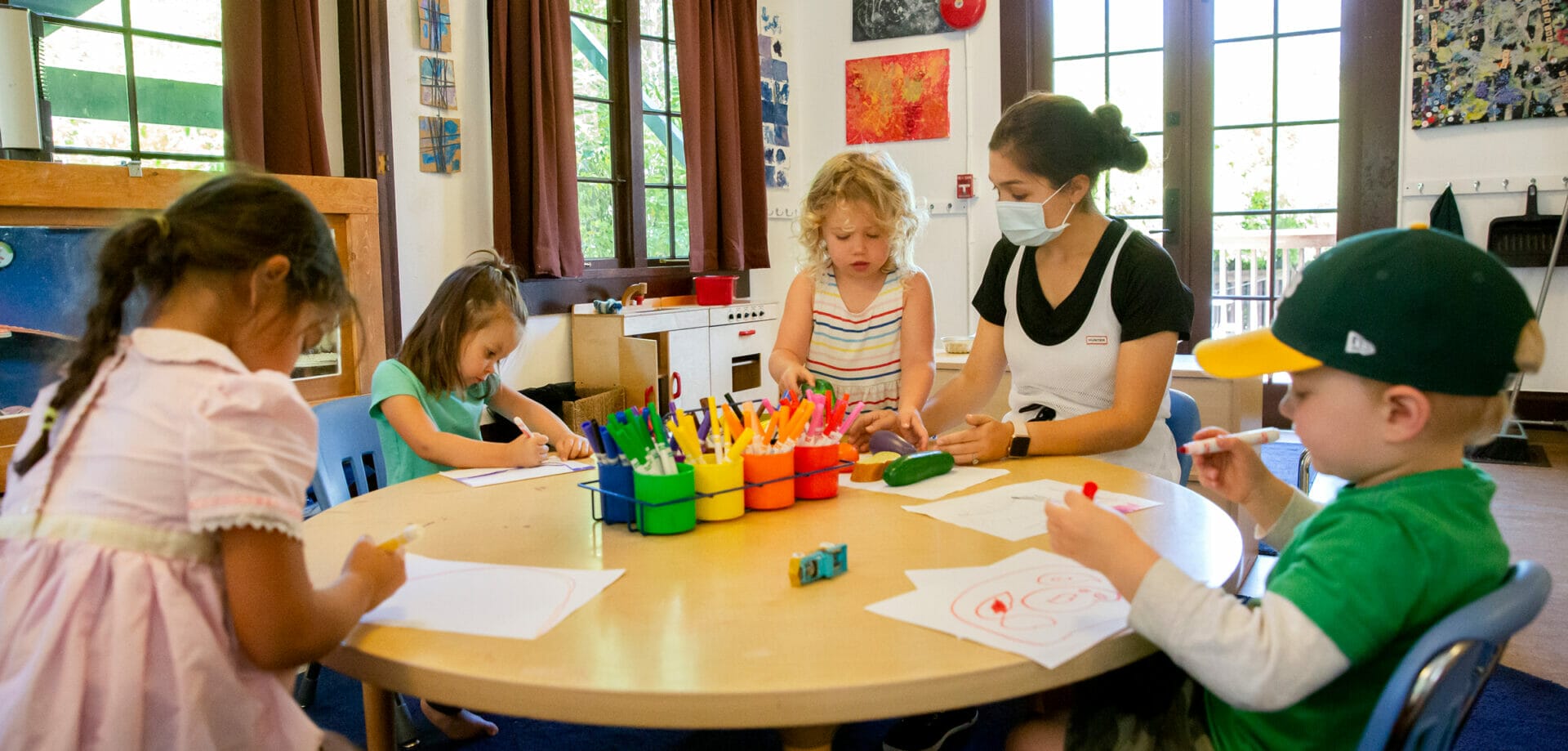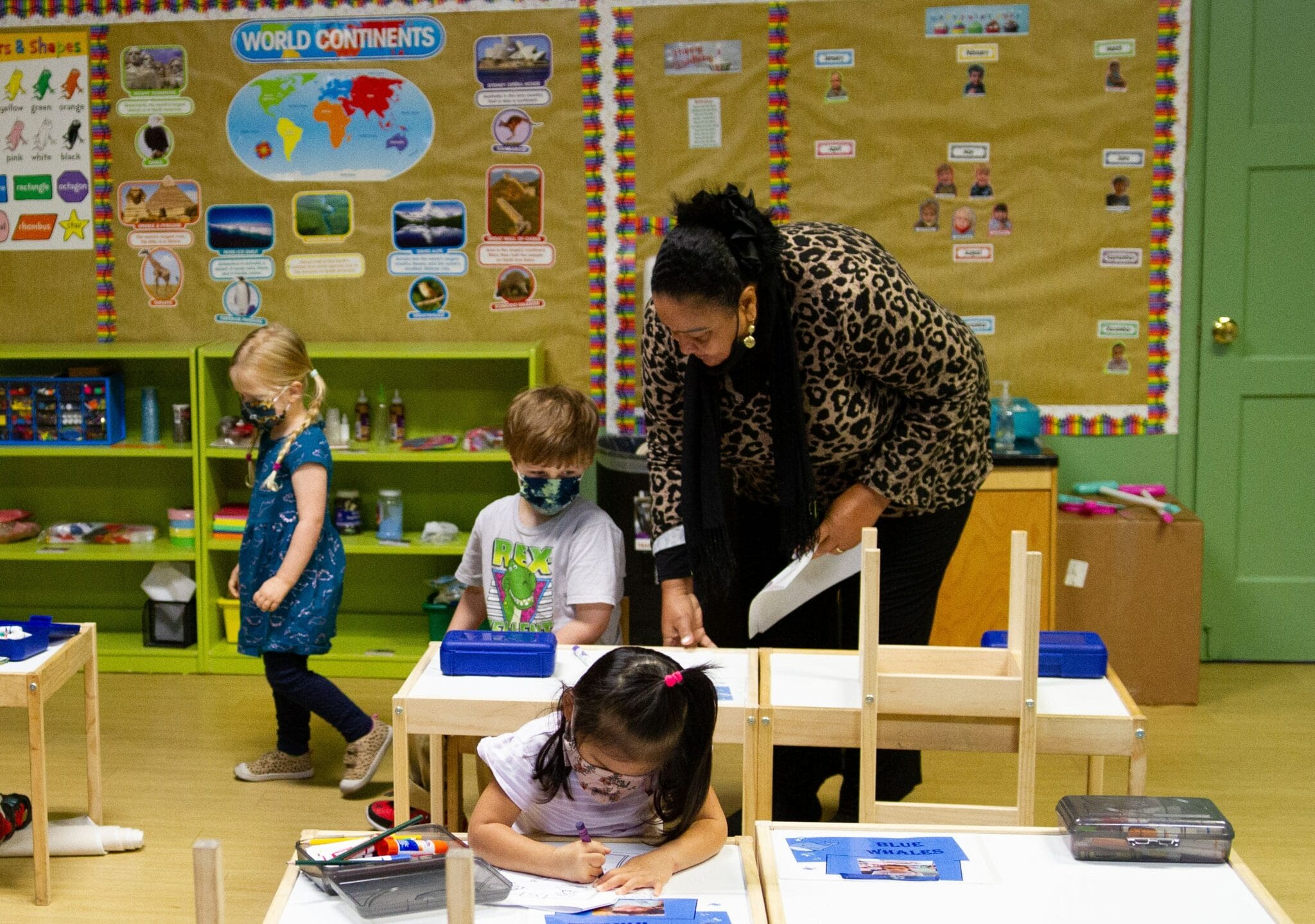“It isn’t okay for school-age children to be in a ‘typical school setting,’ but it is okay for them to be in a ‘typical child care setting’… As a professional in the field, this is hurting my entire soul.”
Tamara Johnson, Wisconsin
As the coronavirus pandemic rages on, hopes of safely returning to in-person learning this fall have evaporated for millions of K-12 students, leaving families scrambling to find care and confronting the nation with a long-standing fact: our schools also provide child care, not only education. The physical closure of schools has made clear that families and employers depend on K-12 schools to educate AND care for our children during the week, and we desperately miss their essential service on both counts.
K-12 teachers resist the caregiving label, in part because caregiving work has long been considered demeaning and such an association risks reinforcing the decades-long onslaught against teachers’ skills and pay. On the other side of this thin coin, early educators’ caregiving functions far overshadow their significant teaching functions, which contributes to their skills being dismissed and devalued, and thus, their exploitation is rationalized. Those who educate and care for infants, toddlers, and preschool-age children are among the lowest-paid workers in every state. Early educators experience poverty at rates double those of workers in general and four to fourteen times higher than K-12 teachers, depending on the state. They are almost exclusively women and are much more likely to be women of color compared to the K-12 workforce.
The societal distance between how the United States treats K-12 teachers and early childhood educators has widened during the pandemic, despite the blurred distinctions between school and child care.
Policy responses to COVID-19 – layered atop the entrenched differences in how we define, fund, and govern schools and child care – have forced most early educators to choose between their livelihood and their own health.
Responding to early guidance from the Centers for Disease Control and Prevention, nearly every state shuttered their K-12 public schools. Nonetheless, K-12 teachers and other school employees continued to be paid and receive benefits; most of them have been able to work, albeit not without challenges, primarily from home as their schools physically closed. Conversely, nearly all states allowed child care programs to remain open, with only a third of these states limiting child care services to children of emergency or essential workers.
As an example, in California, policy guidance stated that priority should be given to children of essential workers but did not restrict services to those populations. Publicly funded preschool programs throughout the state, whether located on K-12 school campuses or community-located state preschool and Head Start were able to close for safety reasons, while continuing to receive funding in order to cover staff compensation and other operating expenses. However, the vast majority of California child care programs, which are privately owned or operated and primarily funded by parent fees, were forced to lay off or furlough staff or reduce their hours, whether they were open or closed. Most of these programs say they are open because they cannot afford not to be. In early June, California lifted the guidance to prioritize certain children, and currently, approximately 9,300 child care centers and 24,500 family child care homes are open for business.
In contrast, in mid-July, California Governor Gavin Newsom imposed stringent rules on K-12 school reopening for in-person instruction that take into account community transmission rates, availability of COVID-19 testing for teachers, and compliance with proper classroom ventilation requirements and other new public health guidelines. No equivalent policies exist for child care in California, a double standard regarding safety policy that is a familiar pattern across states. Meanwhile, our latest survey of California child care providers revealed that more than one-third of open programs continue to have difficulty obtaining and paying for the proper sanitizing supplies and PPE they need to protect themselves.
Irrespective of the ages of the children, many teachers are rightfully terrified of contracting COVID-19 and dying, and they are terrified of the risk to their own families.
Early educators’ fears are magnified because they are far less likely than K-12 teachers to have employer-paid – or indeed any – health coverage or paid sick leave should they become infected or a pension should they be forced to retire in order to protect their health. Further exacerbating their health risks, early educators are more likely than their K-12 counterparts to experience economic insecurity and also more likely to be Black or Latinx, populations that are most at risk from becoming sick or dying from COVID-19.
As of September 14, the Department of Social Services had received reports of 2,505 positive cases among people associated with licensed child care programs in California, most of which were among adults – an increase of 1,451 positive cases in the 60 day period since mid-July. Other states are also tracking the number of cases among children and adults in child care settings, although they vary with regard to whether all programs are required to report and whether they release the data to the public. What’s more, the scarcity of COVID pediatric testing casts even more doubt on how many children carry and transmit the virus. Most testing centers in urban areas either refuse to test or exclude young children.
While the data do not allow us to adequately assess the role of child care in spreading the virus, support has weakened for the argument that child care is relatively risk-free as knowledge about COVID-19 continues to develop. Most recently, healthy children have been found to carry viral loads that are higher than those of some adults hospitalized by the virus, raising concerns among scientists that children may be more active spreaders than initially presumed. These developments are worrisome for the teacher who cannot afford to be tested or who must stay home without pay while awaiting test results, let alone a two-week unpaid quarantine if she or others in the program test positive.
“We need health insurance. One of my co-workers is afraid to go to work. Right before all this happened, her husband got some trivial hourly pay increase which kicked them off Medicaid, and she can’t afford the health insurance we offer, so she has nothing. That can’t happen if you’re calling us an essential class of workers.”
Kyra Swenson, Wisconsin
While teachers’ health concerns are prompting revisions to K-12 approaches, no such consideration for child care has emerged. For example, Massachusetts announced a rapid-response COVID-19 testing plan for schools, but completely left out child care. As K-12 schools remain physically closed or develop extra safety resources to protect teachers and staff, the pressure on child care to remain open and expand, with few resources, has only increased. Families and even schools are turning to child care programs to supervise older children participating in remote learning. There seems to be no consideration for early educators enduring the very trade-off between their safety and their own livelihood that K-12 teachers are trying to avoid.
Schools and child care are necessary supports for our economy and the development of our society as a whole, but only the former is treated as a public good. Our reliance on a market-based system of child care has made early childhood educators especially vulnerable to the impacts of COVID-19.
As K-12 schools closed temporarily and then transitioned to distance learning, public school leaders never had to choose between serving children in person or losing their revenue. Teachers were not placed on unpaid leave, and parents were not asked to pay for their child’s place in a classroom or risk having nowhere for their child to return to school. Yet, all of these circumstances apply when it comes to child care in the United States during the pandemic.
Most early care and education services are purchased in the marketplace by families. Publicly funded child care services generally have narrow eligibility requirements, and all publicly subsidized services are underfunded and oversubscribed. Before COVID-19, these conditions fueled a system that financially overburdened parents, but still underfunded programs and, thus, kept the wages of teachers at poverty levels. Imagine if parents had to individually shoulder the cost of third grade or if teachers’ wages were determined by what parents could afford. During COVID-19, these conditions – coupled with the policy failures that have pushed parents to work – have compelled programs in many states to stay open even when staff feel unsafe or lack the equipment and supplies they need to operate as safely as possible.
Absent policies and resources that allow them to stay home during the pandemic, school and child care closures harm working parents – especially mothers, who are much more likely to reduce work hours or exit the workforce altogether to assume child care duties. In a conflict born out of a longstanding inadequate early care and education system and magnified by the failed policy response to COVID, the needs of one group of women (child care teachers and providers) have been pitted against another group of women (working mothers).
We must ask and answer this question: Why is the early care and education workforce expected to shoulder so much of the care and education crisis laid bare and intensified by our nation’s insufficient response to a global pandemic?
It is no coincidence that this expectation falls on early educators who are poorer, less organized, and more likely to be women of color than teachers of older children. A clear message has been sent to the women caring for and educating our nation’s youngest children: your services are essential, but you are expendable and less worthy of protection than your K-12 counterparts. We should all find this expectation alarming, morally repugnant, and wholly unacceptable.
Early educators’ lives and livelihoods are at stake, yet any relief seems increasingly unlikely before the start of the next presidential term. Right now, at the very least, local and state policymakers have a responsibility to ensure that staff working in child care programs are:
- Provided with the PPE and sanitizing supplies they need for themselves and the children in their care;
- Provided free access to COVID-19 testing;
- Guaranteed paid sick leave if they must quarantine because of a positive test or exposure to the virus or if they become symptomatic;
- Guaranteed health coverage for themselves and family members in their household; and
- Guaranteed to earn no less than the locally assessed living wage.
The exploitation of the hard work and dedication of early educators who have continued to show up for children and families must stop.
We cannot expect them to bear the burden of economic recovery without appropriate protection and compensation. We have seen increased expressions of gratitude for early educators and their work during this time of crisis, which is necessary and also should be a continued aspect of the culture post-pandemic. Still, quite frankly, appreciation does not protect their health or their livelihood – just ask an early educator.



